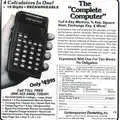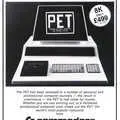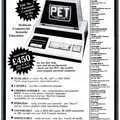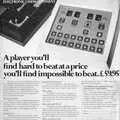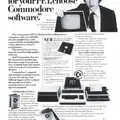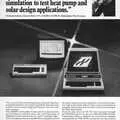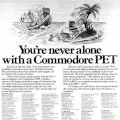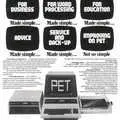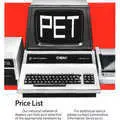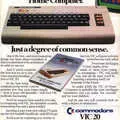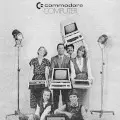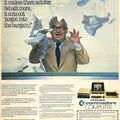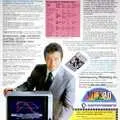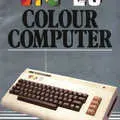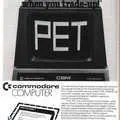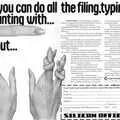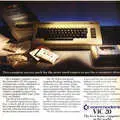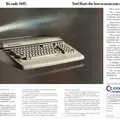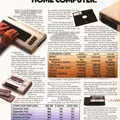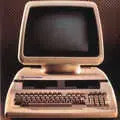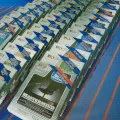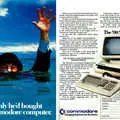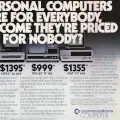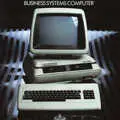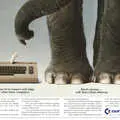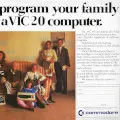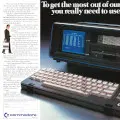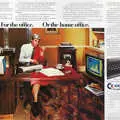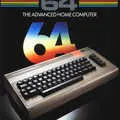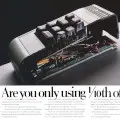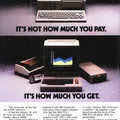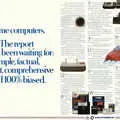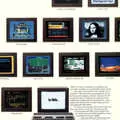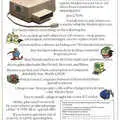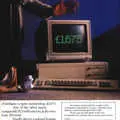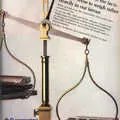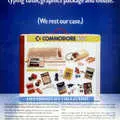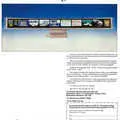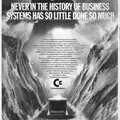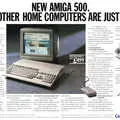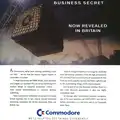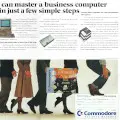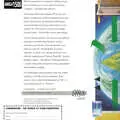
Commodore Advert - July 1984
From Business Magazine
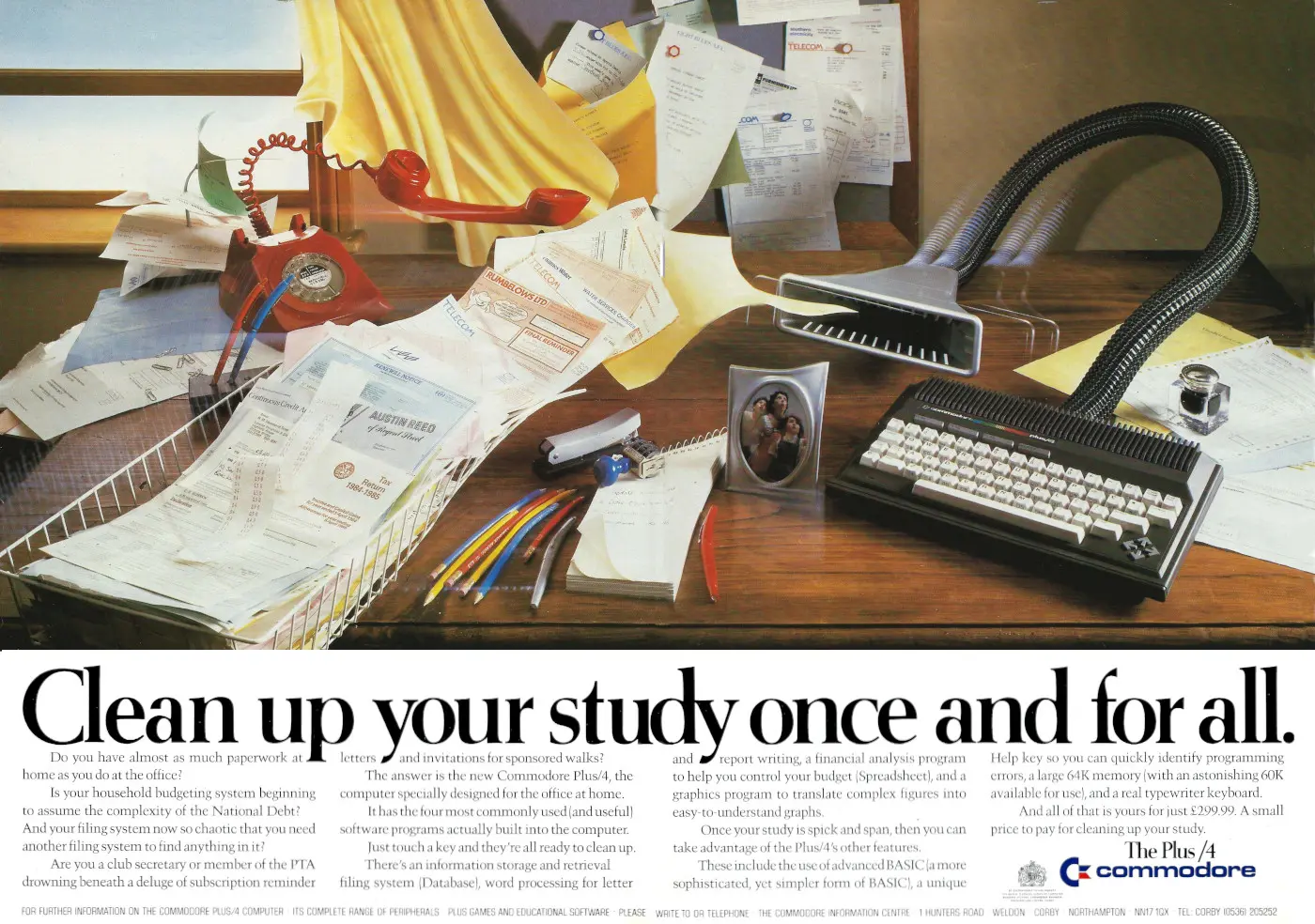
Commodore Plus/4: Clean up your study once and for all
Here's a nice advert showing Commodore's Plus/4 as some sort of vacuum cleaner, sucking up a load of invoices, receipts and a tax return.
There are some great 80s names in the in-tray, including the London Electricity Board (privatised in 1990) and high-street television and radio rental shops Rumbelows - from where Commodore's computers could also be bought - which folded in the mid 90s.
First announced at the January 1984 Winter Consumer Electronics Show in Las Vegas, the Plus/4 was something of an attempt to get back to the production ethics of the VIC-20, with as few components as possible to keep it cheap - at least compared to the Commodore 64, which was initially much more expensive to make.
The machine had first been demonstrated as a prototype a year before at the 1983 Winter CES. Originally known as the 444, it had the latest upgraded version of the 6502/6500-series CPU - the 7501, and later the 8501 - and was also the first machine to use Commodore's new TED chip.
The TExt Display - or TED - was a multi-purpose processor which, it was hoped, would combine some of the functions of a micro which previously relied on individual chips - video display, sound, memory and I/O handling - thus reducing costs[1].
There was also a rarely-mentioned and seemingly never-released alternative version of the 264 planned.
Called the V364, it included a built-in voice synthesizer with a vocabulary of 250 words, an increased 48K ROM and a bigger keyboard with an additional numeric keypad[2].
In fact Commodore had been planning a whole range of micros, built on the basis of a modular design which offered three types of keyboard and different amounts of memory - from 16K to 64K in 8K steps.
The two models announced in early 1984 were just two of this possible range - the 116 indicated a type 1 calculator or chiclet keyboard with 16K memory, and the 264 indicated professional keyboard with 64K memory, hence the V364 was the voice version with an even more professional keyboard.
The choice of a modular design was said to reflect the different stages of development of Commodore's market around the world, where its subsidiaries each had very different requirements[3].
However, even though the Plus/4 was touted as "a more advanced machine than the existing Commodore 64" and even though it had generally good graphics, it did not support sprites and its sound was more like the much older VIC-20.
The lack of sprites and its 64K memory effectively rendered it not much better than, but largely incompatible with, the actual Commodore 64, which by this time had amassed a large software library.
This ended up placing the Plus/4 in something of a no-man's land, which led to poor sales, particularly in the US.
The Plus/4 also included built-in software on ROM, which was aimed at making it seem something a bit more serious that could be used in a home office. Sig Hartmann, president of Commodore Software was interviewed as saying:
"The key area we're emphasizing in software for the 264 [Plus/4] is productivity, covering areas such as household management, word processing, business accounting and education"[4].
Commodore planned to have "more than 30" software products available either on cartridge, tape or floppy by the time the Plus/4 launched.
Unfortunately, the built-in applications weren't considered to be particularly good[5], although this was perhaps a bit unfair given the intended market - homes and perhaps small businesses.
Interviewed in Compute's Gazette, VP Marketing for the computer systems division of Commodore, Myrddin Jones, said about 3-plus-1, the built-in software on the Plus/4 whose name was a play on the then-popular Lotus 1-2-3, that:
"It brings the technology down to the right level. It's got enough variety for the average small business. We've converted it, with graphics, into something they can visualize very easily with very little instruction. It's nowehere near a Lotus 1-2-3, but it gives you enough of the kind of capability that the average user can get mileage out of[6]".
The Plus/4 or 264 also wasn't particularly fast. In an update of its benchmarks, Personal Computer World published a league table in the summer of 1985 which showed that Commodore's own VIC-20, launched in September 1981, was still 14% faster than the Plus/4, despite the near three years of development between them.
That said, the venerable VIC also managed to be faster than the Apple II, Dragon 32, Oric Atmos and ZX Spectrum - the latter by almost a factor of two[7].
It was not all bad news for Commodore though: during the same Winter CES show in Las Vegas, it also announced that it had become the first ever computer company to top sales of $1 billion dollars (about £4 billion in 2025 terms).
This was more than double the previous year's figure of $458 million[8].
After the machine had been announced, plans in the UK were apparently well underway for a May or June launch, although management reshuffles within Commodore following the departure of founder Jack Tramiel had thrown that in some doubt, with speculation in the US that Commodore was putting back plans for the 264's release to the end of the year.
This was based largely on a quote from Commodore's general manager Sol Davidson, who had said that Commodore was re-examining the 264 and would introduce it "when there is a need for it".
John Baxter, Commodore UK's marketing manager, was quick to deny this, stating that "we already have machines in the country and have already started to make arrangements for the launch". The final specification was still unknown though, and Baxter followed up by saying:
"we are making no announcements on what the product will be, how much memory it will have or what the price will be until it is launched. There will be a lot of surprises when it is launched".
He also hinted that it may be released in Europe before the US, as the FCC's stringent radio-interference requirements were thought to be holding it back[9].
A couple of months later, after the 264 and its sibling the 116 had been launched in Europe at the Hanover Computer Fair during the second week of April, Baxter appeared to back-track on the future of the 264 (Plus/4), suggesting that the original June launch was now not the case, saying "We have not decided on a date for its introduction".
Baxter also announced that the estwhile 116 machine - a 16K micro with a toy-like chiclet keyboard, was to be shelved indefinitely - "We don't think there is a market for it in Europe"[10].
According to Popular Computing Weekly, Commodore didn't seem too convinced about its own machine, with Howard Stanworth - Commodore UK's general manager - warning journalists at the launch of the Plus/4 not to pre-judge the machine by the adverse press reaction in the US.
The magazine continued by suggesting that both Commodore and Sinclair appeared to be "treading water" by being cautious, making the most of their respective software strengths whilst "working out what to do next"[11].
Commodore cast even more doubt over its own machines at the beginning of the new year, when disappointing sales and poor software support led Commodore's US vice-president of marketing Frank Leonardi to report:
"The Plus/4 and C16 are not selling well in the States, largely because of lack of advertising. They will have to be repositioned in the marketplace".
Up to that point there had been no software at all released for the Plus/4 in the US by any of the independent software houses. Popular Computing Weekly commented on the possible death throes of the machines, suggesting:
"with the launch of the C128 and LCD portable machines, both of which are partially-compatible with the C64, the non-64-compatible C16 and Plus/4 appear now rather left out by Commodore".
In the UK, things weren't quite as gloomy, with Dave Gilbert of Dixons reporting:
"They are selling as well as we expected, and the C16 is doing quite well. Sales of the Plus/4 are more limited".
Perhaps the most damning indictment though was that "it's not selling as well as the QL", whilst John Flatman of Boots was even less positive, saying that:
"sales have been disappointing in comparison to our own expectations. We were hoping that the C16 would be a low-end competitor to the Spectrum and it just didn't happen".
Commodore for its part was putting a brave face on it, with UK software development manager Chris West saying:
"The Plus/4 is actually doing better than we thought it would. We are on target for 100,000 sales by March"[12].
Although initially pitched as something businessey, by the end of February 1985 the price of the Plus/4 was drastically cut in a surprise move by Commodore UK, which seemed to elicit mixed reactions in the press.
Its new price of £149 put it more firmly in Electron or Spectrum territory, which somewhat put paid to the company's original claim that the Plus/4 was not aimed at the same market.
According to Marketing Manager David Gerrard, this was necessary as the price of both the competitors had recently been reduced.
Gerrard was also having to defend the impact of the price cut on the C64, suggesting that:
"The Commodore 64 is in a different market; it is noted for its communications, sound and graphics capabilities. Besides, it's an institution, and you can't get rid of institutions".
Gerrard also reckoned that the Plus/4 would "have a dramatic effect on Sinclair and Acorn".
The price change also meant that the C16 was left isolated and whilst Commodore announced that it was not intending to reduce the price of this machine, both Curry's and Dixons cut the price of the C16 starter pack to only £80 anyway (£320 in 2025), no doubt to the annoyance of recent Christmas buyers.
Commodore Horizons at least was suggesting that it was time to realise that the two machines would never make the impact that Commodore had clearly hoped they would, and that, echoing David Gerrard, the C64 was just too much of "an institution"[13].
One explanation suggested for the drastic price cut was that Commodore was phasing the Plus/4 out in the UK and so the company was selling off its remaining stocks as quickly as possible, a situation that Gerrard categorically denied, stating that:
"The Plus/4 will continue to be manufactured in Corby. We went into production of the Plus/4 at a very low level to start with - now we've changed our minds"[14].
Shortly after the dramatic 50% UK price cut, Commodore's president Marshall Smith flew in to the UK - a visit which coincided with the unexplained resignation of UK general manager Howard Stanworth, although later Commodore would say that the split was "amicable".
Commodore wouldn't admit any connection between the two events, but it was said that the suspected unauthorised price cut had not "gone down well with the American board", where the price of the Plus/4 remained at around $300 - about £800 in 2025 and about 50% more expensive than Commodore's price in the UK.
Officially, Stanworth had said that the price cut was "an opportunistic reponse to market conditions" - likely a reference to the problems happening over at Acorn, which was in the process of being bailed out by Olivetti.
However, it was widely seen as an admission that the Plus/4 wasn't doing so well, mostly because of "a lack of interest from software suppliers"[15].
In the summer of 1985 the Plus/4's price was cut yet again, when High Street chain Dixons started selling the machine for 60p less than £100.
Commodore, meanwhile, was moving to bundled deals in an attempt to shift units, with its business pack, which included a 1541 disc drive, printer and Impex software, at £449.
Dixons' David Gilbert said "I don't know if we will be stocking the business pack", whilst Commodore said sniffily of Dixons' unilateral price-cut that "Obviously Dixons is at liberty to do what it pleases over price cuts.
Dixons' new price will not affect the Business Pack in any way"[16].
There was further turmoil at Commodore's UK factory and head office Corby when 100 assembly-line workers were laid off, apparently the result of "seasonal variations in staffing requirements", and Aileen Bradley of the marketing department left along with "a number of other permanent staff"[17].
There was more disruption at the end of May when a further eight high-level employees left the company.
These included four vice-presidents - Bernhard Witter, VP Finance; Greg Pratt, VP Manufacturing and Assembly; Lloyd Taylor, VP Technology and, most significantly, Taro "Tony" Tokai, VP of Commodore's Japan unit and lynchpin of the VIC-20 project.
Also gone was Sam Tramiel, who left to join Tramel Technology Limited - founded by Jack - and PET legend John Feagans, Commodore's Director of Software Technology.
Marshall Smith suggested that this was all part of "internal restructuring" and that "the organisation has been streamlined as a result"[18].
Despite the poor sales, indifferent reviews and constant rumours of its demise, the Plus/4 stuck around until at least the beginning of 1986.
Back in the Autumn of 1985 Commodore's latest UK marketing manager Chris Kaday said that the company was not dropping the Plus/4 but that it was busy "building the existing components in to finished units [to] make space for the manufacture of the 128" and that it and its sibling C16 would be available for sale over Christmas and will be supported afterwards[19].
However by around April of 1986, Commodore User's Dan Gutman was reporting that:
"it looks like they're completely dumping the Plus/4 [in the US]. You don't see it in the stores here - you see it advertised on sleazy late-night television commercials. They're selling the thing for $99 now. That's about a third of the original [price] - just about giveaway prices. My guess is that they'll unload as many as they can and discontinue the machine entirely"[20].
Throughout the Autumn of 1985 in the UK, Commodore had been selling the Plus/4 as a bundle complete with the 1531 datasette, joystick and ten sofwtare titles for just £100, whilst Lasky's was selling with a 1541 disc drive, MPS 803 printer and a bunch of business software for £300, or £1,200 in 2025[21].
The Plus/4 by itself had initially retailed for £299.99 - about £1,260 in 2025 terms.
Date created: 01 July 2012
Last updated: 25 August 2025
Hint: use left and right cursor keys to navigate between adverts.
Sources
Text and otherwise-uncredited photos © nosher.net 2025. Dollar/GBP conversions, where used, assume $1.50 to £1. "Now" prices are calculated dynamically using average RPI per year.
